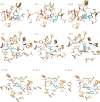Bioactivity and Molecular Docking Studies of Derivatives from Cinnamic and Benzoic Acids
- PMID: 32596343
- PMCID: PMC7273447
- DOI: 10.1155/2020/6345429
Bioactivity and Molecular Docking Studies of Derivatives from Cinnamic and Benzoic Acids
Abstract
Over the last decade, there has been a dramatic increase in the prevalence and gravity of systemic fungal diseases. This study aimed therefore at evaluating the antifungal potential of ester derivatives of benzoic and cinnamic acids from three Candida species. The compounds were prepared via Fischer esterification, and the antifungal assay was performed by the microdilution method in 96-well microplates for determining the minimal inhibitory concentrations (MICs). The findings of the antifungal tests revealed that the analogue compound methyl ferulate, methyl o-coumarate, and methyl biphenyl-3-carboxylate displayed an interesting antifungal activity against all Candida strains tested, with MIC values of 31.25-62.5, 62.5-125, and 62.5 μg/ml, respectively. A preliminary Structure-Activity Relationship study of benzoic and cinnamic acid derivatives has led to the recognition of some important structural requirements for antifungal activity. The results of molecular docking indicate that the presence of the enoate moiety along with hydroxyl and one methoxy substitution in the phenyl ring has a positive effect on the bioactivity of compound 7 against Candida albicans. These observations further support the hypothesis that the antifungal activity of compound 7 could be due to its binding to multiple targets, specifically to QR, TS, and ST-PK. Additional experiments are required in the future to test this hypothesis and to propose novel compounds with improved antifungal activity.
Copyright © 2020 Yunierkis Perez-Castillo et al.
Conflict of interest statement
No potential conflict of interest was reported by the authors.
Figures



References
-
- Wang W., Dong G., Gu J., et al. Structure–activity relationships of tetrahydrocarbazole derivatives as antifungal lead compounds. Medicinal Chemistry Communications. 2013;4(2):353–362. doi: 10.1039/C2MD20211E. - DOI
-
- Sharanappa R., Vidyasagar G. M. Anti-Candida activity of medicinal plants: a review. International Journal Pharmacy and Pharmaceutial Sciences. 2013;5(4):9–16.
MeSH terms
Substances
LinkOut - more resources
Full Text Sources

